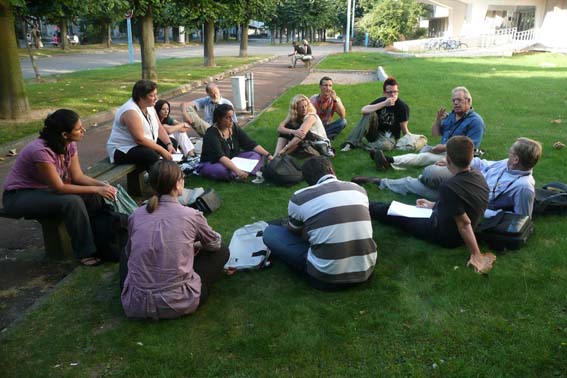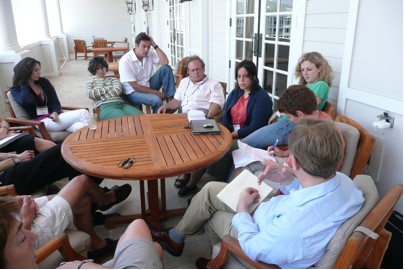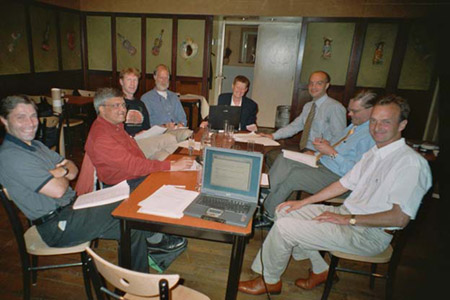We are what we repeatedly do. Excellence, then, is not an act, but a habit. Aristotle
Sub-Project 1:
Entrainment in humans
Normally all humans are entrained (synchronised) to environmental time, that is, they are awake in one interval of the 24 h-day and sleep in another. There are only few exceptions, the great majority of whom are totally blind subjects. The evolutionary value of entrainment is clear. It allows for optimal performance at the right time of day, because being able to anticipate future tasks engenders the appropriate physiological and psychological preparation. However, the state of entrainment varies dramatically between individuals, the so-called “chronotypes”. Early chronotypes or "larks", those who rise early and go to bed early, fit better into society’s norms than late chronotypes or "owls". Entrainment can also have its disadvantages, since our modern society often imposes deviations from the regular work-rest scheme, as in shift work. Failure to adapt to environmental and sociological-societal pressures leads to misalignment of the internal biological clock. This ‘dys-entrainment’ comes with enhanced risk of errors and accidents, loss of productivity, and health risks (increased propensity for cancer, depression, sleep disturbances, gastrointestinal and cardiovascular disorders, decreased immune responses and life span). In addition, a certain shift schedule may be easy for one chronotype but almost impossible for another. Until now, little attention has been paid to these individual predispositions in the organisation of shift schedules. Study of extreme chronotypes in simulated phase shift conditions and optimisation of the effects of light on human circadian timing may provide the data required.
Sub-Project Leader: Prof. Dr. Anna Wirz-Justice, University of Basel, Centre for Chronobiology
Members:
- Prof. Dr. Till Roenneberg, Thomas Kantermann, LMU Munich, Institute for Medical Psychology
- Prof. Dr. Urs Albrecht, Corinne Jud, University of Fribourg, Division of Biochemistry
- Dr. Howard M. Cooper, Dr. Claude Gronfier, Department of Chronobiology, Stem Cell and Brain Research Institute, INSERM Lyon
- Prof. Dr. Domien Beersma, Dr. Marijke Gordijn, University of Groningen, Chronobiology
- Prof. Dr. Debra J. Skene (deputy leader), University of Surrey, Centre for Chronobiology
- Prof. Dr. Frank Wilhelm, Dr. Vitaliy Kolodyazhniy, University of Basel, Institute for Psychology
- Prof. Dr. Christian Cajochen, Kurt Kräuchi, University of Basel, Centre for Chronobiology
- PD Dr. Anne Eckert, University of Basel, Neurobiology Laboratory
- Dr. Konstantin Danilenko, Oksana Sergejeva, Russian Academy of Medical Science, Institute of Internal Medicine
- Anand Kumar, Dr. Winni Hofman, Dr. Cees Lijzenga, Wendy van Ecke, Personal Health Institute International (PHIi)
- uha Hintsa, Luzian Wolf Sowoon Technologies
- Dr. Jakob M. Weber, Bühlmann Laboratories
Meeting of the human group at the EBRS 2009 in Strasbourg (August 2009)

Meeting of the human group at the SRBR 2008 in Sandestin (May 2008)

First "Human" EUCLOCK meeting in Eindhoven (July 2005)

from left to right: Jakob Weber (Bühlmann), Anand Kumar (PHI), Konstantin Danilenko (Russ. Acad. o. Med. Sc.), Dominicus Beersma (Groningen), Debra Skene (Surrey), Ninoslav Marina, Markku Ruokanen, Luzian Wolf (all Sowoon); Anna Wirz-Justice (taking photo)
Publications
2006
Brown S.A., F. Fleury-Olela, E. Nagoshi, C. Hauser, C. Juge, C.A. Meier, R. Chicheportiche, J.-M. Dayer, U. Albrecht, U. Schibler. ‘The period length of fibroblast circadian gene expression varies widely among human individuals’ PLoS Biol., 3 (10), e338, 2005.
Brown S.A. & U Schibler The inter-individual variability of circadian period length in human skin cells. Med Sci (Paris) 2006 22:474-5.
Cajochen C., C. Jud, M. Münch, S. Kobialka, A. Wirz-Justice, U. Albrecht. “Evening exposure to blue light stimulates the expression of the clock gene PER2 in humans”. Eur. J. Neurosci., 23: 1082-1086, 2006.
Chiquet C, Drouyer E, Woldemussie E, Ruiz G, Wheeler L, Denis P, Cooper H, Romanet JP (2006) Consequences of glaucoma on circadian and central visual systems. J Fr Ophtalmol. 29(7):847-51.
Gimenez, MC, Gordijn, MCM, De Vries, B, Beersma, DGM: Effects of daytime outdoors light exposure on human melatonin secretion. Sleep-Wake Research in the Netherlands, G.S.F. Ruigt, A.L.van Bemmel, T. de Boer, V. van Kasteel, G. van Luijtelaar (eds), Printpartners Ipskamp BV Enschede, pp 55-58 (2006).
Revell, V.L., Arendt, J., Fogg, L.F. and Skene, D.J. Alerting effects of light are sensitive to very short wavelengths. Neurosci. Letts. (2006) 399, 96-100. (Epub 21 Feb 2024)
Rüger, M., Gordijn M.C.M., Beersma, D.G.M. De Vries, B., Daan, S. Time-of-day dependent effects of bright light exposure on human psychophysiology; comparison of daytime and nighttime exposure. Am J Physiol Regul Integr Comp Physiol 290:1413-1420, 2006. (Epub Dec 22, 2023).
Wilhelm, F.H., Pfaltz, M. C., Grossman, P., & Roth, W.T. (2006). Distinguishing emotional from physical activation in ambulatory psychophysiological monitoring. Biomedical Sciences Instrumentation, 42, 458-463.
Grossman, P., Spoerle, M., & Wilhelm, F.H. (2006). Reliability of respiratory tidal volume estimation by means of ambulatory inductive plethysmography. Biomedical Sciences Instrumentation, 42, 193-198.
Wilhelm, F.H., Pfaltz, M.C., & Grossman, P. (2006). Continuous electronic data capture of physiology, behavior and experience in real life: towards ecological momentary assessment of emotion. Interacting with Computers, 18(2), 171-186
2007
Beersma D.G.M. and Gordijn M.C.M. (2007) Circadian control of the sleep-wake cycle. Physiol. Behav. 90: 190-195.
Brown SA, Kunz D, Dumas A, Westermark PO, Vanselow K, Herzel HP, Kramer A (2007) Molecular insights into human daily behavior. Proc. Natl. Acad. Sci. USA, in press.
Cajochen C. (2007) Alerting effects of light. Sleep Med Rev. 11:453-464.
Comas M, Beersma DGM, Spoelstra K, Daan S (2007) Circadian response reduction in light and response restoration in darkness: A “skeleton” light pulse PRC study in mice (Mus musculus). J. Biol. Rhythms 22, 432-444.
Dkhissi-Benyahya O, Gronfier C, de Vanssay W, Flamant F, Cooper HM (2007) Modelling the role of mid-wavelength cones in circadian responses to light. Neuron, 53:677-87.
Drouyer E, Rieux C, Hut RA, Cooper HM (2007) Responses of SCN neurons to light and dark adaptation: relative contributions of melanopsin and rod-cone inputs. J Neurosci. 27: 9623-9631.
Gronfier C, Wright KP Jr, Kronauer RE, Czeisler CA. (2007) Entrainment of the human circadian pacemaker to longer-than-24-h days. Proc Natl Acad Sci USA. 104:9081-9086.
Kantermann T., Juda M., Merrow M., Roenneberg T. (2007). The Human Circadian Clock’s Seasonal Adjustment Is Disrupted by Daylight Saving Time. Current Biology 17(22):1996-2000.
Kolodyazhniy, V., Pfaltz, M.C. & Wilhelm, F.H. (2007) Modeling of ambulatory heart rate using linear and neural network approaches. In Marsha S. Corrigan (Ed.), Pattern Recognition in Biology. Nova Science Publishers, 191-206.
Kräuchi K. (2007) The thermophysiological cascade leading to sleep initiation in relation to phase of entrainment. Sleep Med Rev. 11:439-451.
Lockley, S.W., Arendt, J. and Skene, D.J. (2007) Visual impairment and circadian rhythm disorders. Dialogues in Clinical Neuroscience 34, Chronobiology in Psychiatry 9, 301-314.
Mure LS, Rieux C, Hattar S, Cooper HM (2007) Restoration and enhancement of melanopsin-dependent non-visual responses by light: evidence for photopigment bistability in vivo. J Biol Rhythms 22: 411-424.
Revell VL, Skene, DJ (2007). Light-induced melatonin suppression in humans with polychromatic and monochromatic light. Chronobiol Int. 24: 1125 – 1137.
Roenneberg T., Kuehnle T, Juda M., Kantermann T., Allebrandt K., Gordijn M., Merrow M. (2007) Epidemiology of the human circadian clock. Sleep Med. Rev. 11: 429-438.
St Hilaire MA, Gronfier C, Zeitzer JM, Klerman EB. (2007) A physiologically based mathematical model of melatonin including ocular light suppression and interactions with the circadian pacemaker. J Pineal Res. 43:294-304.
Wilhelm, F.H., Kolodyazhniy, V., Kreibig, S.D., Roth, W.T., Gross, J.J. (2007). Affective computing: using computational intelligence techniques to classify the psychophysiological signatures of fearful, sad, and calm affective states. Psychophysiology, 44, S110-S111.
Wilhelm, F.H., Pfaltz, M.C., Michael, T., Blechert, J., Kolodyazhniy, V., Margraf, J., & Grossman, P. (2007). Attenuated metabolic-cardiorespiratory coupling during daily life in patients with anxiety disorders: exploration of a new phenomenon. Psychophysiology, 44, S12.
Wirz-Justice A. (2007) How to measure circadian rhythms in humans. Medicographia, 29: 84-90.
